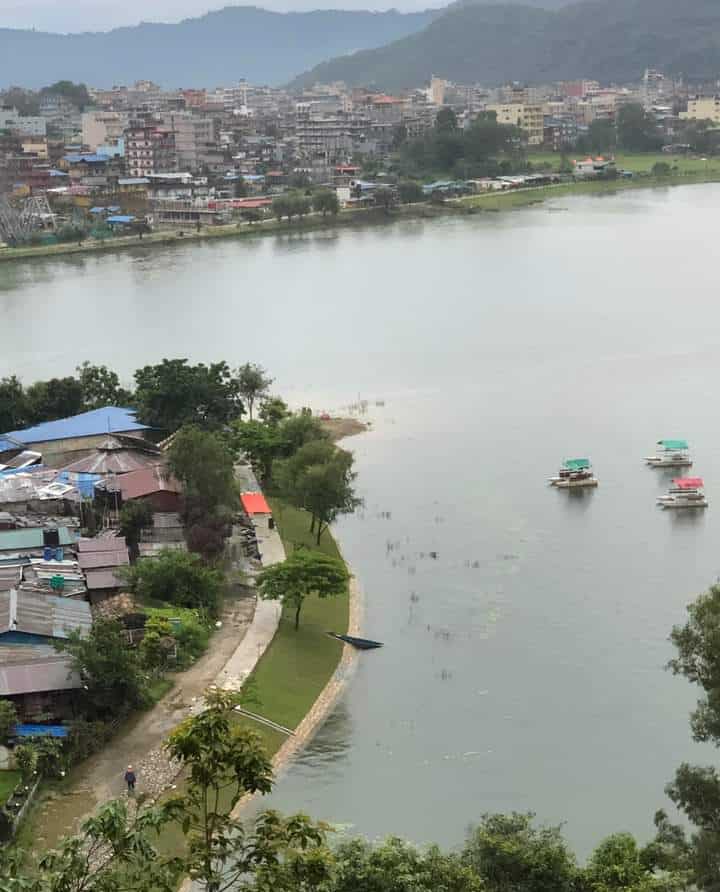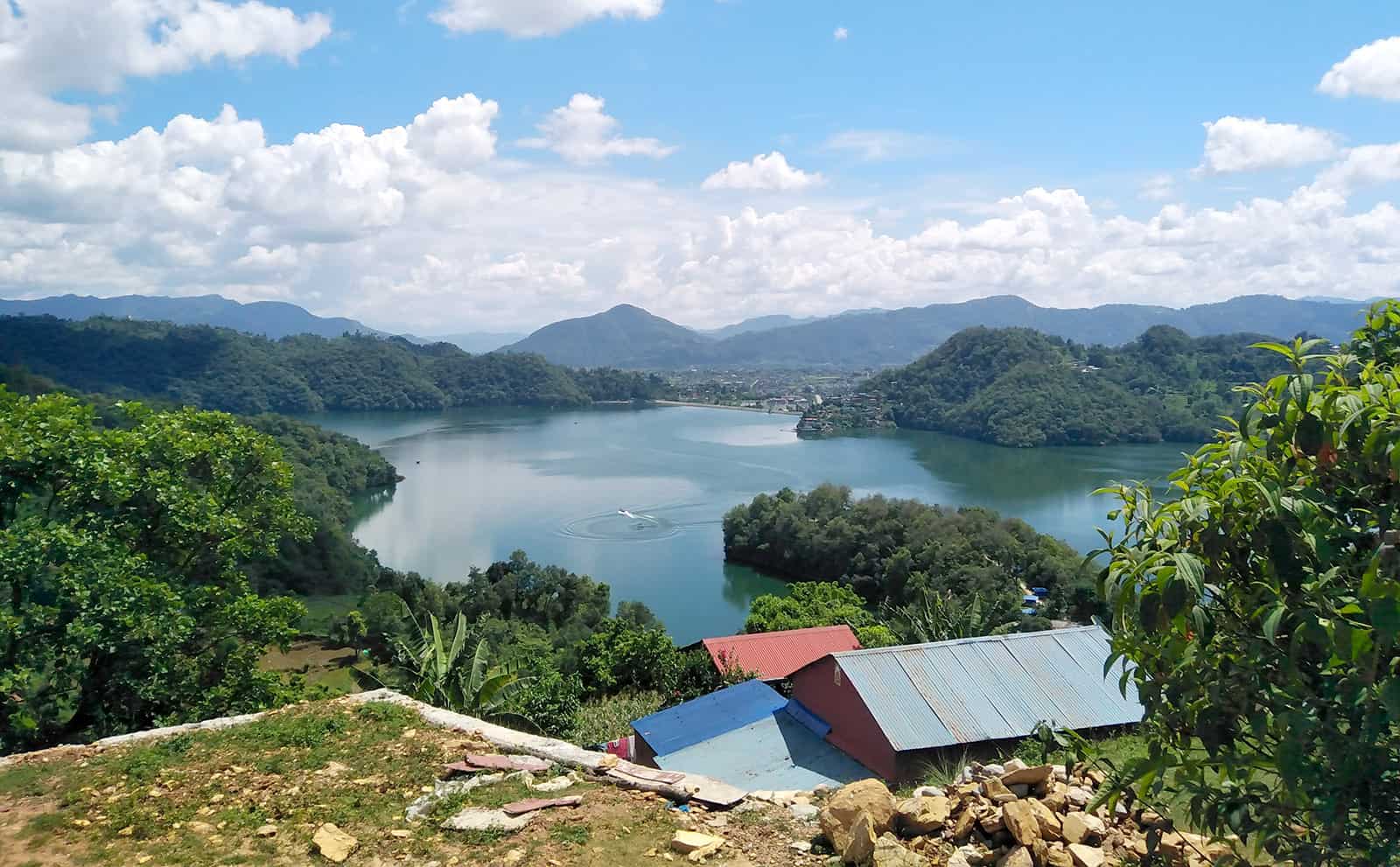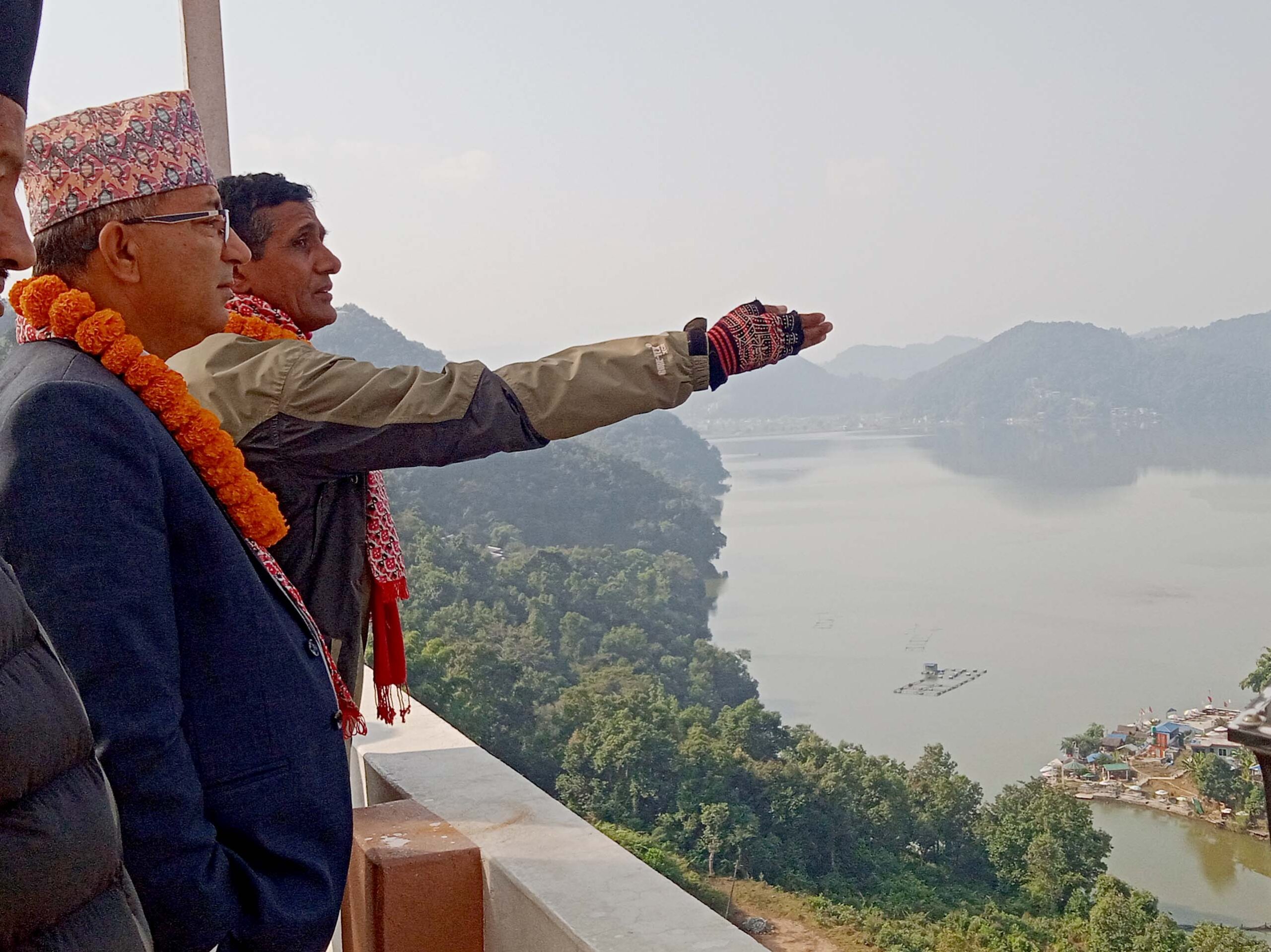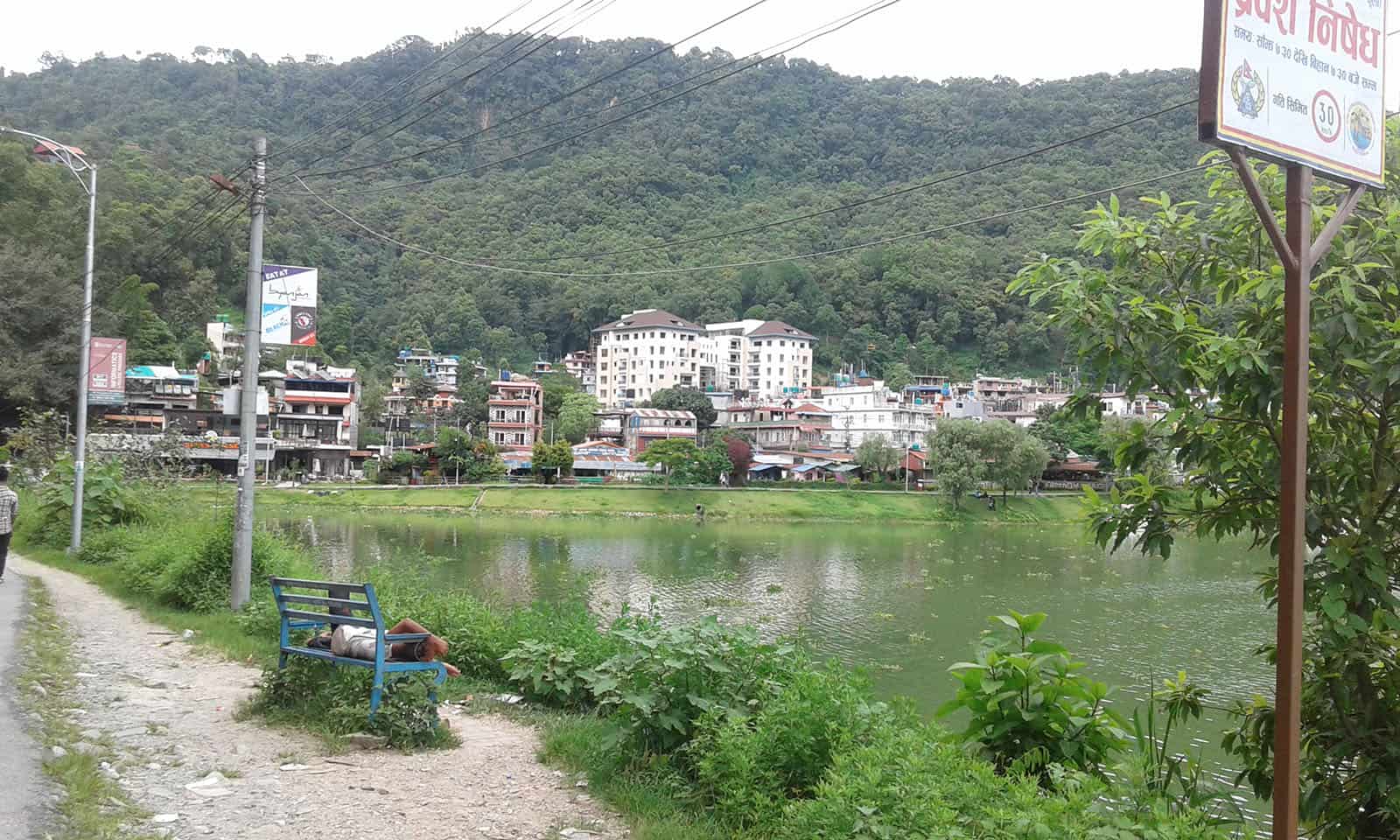Despite court orders to conserve the natural water bodies in the lake city, the government remains indifferent, turning a blind eye as political elites and individuals persistently seize public land to erect concrete structures.
Smita Adhikari |CIJ Nepal

Following the establishment of the local government, hotels and coffee shops on the Phewa bank were opened in breach of standards. Photos: Smita Adhikari
In October 2022, a new hotel was erected a mere 10 meters from the shores of Lake Fewa. Despite violating the standard criteria of maintaining a 60-meter distance from the lake, the hotel was inaugurated by Bishnu Bhattarai, the ward chairperson.
Ishwar Baral, the owner of the hotel, in an interview with the Centre of Investigative Journalism, expressed his admiration for the enchanting view of the lake from the hotel’s upper floors.
Two months after Baral’s hotel was inaugurated, Madhav Prasad Paudel prepared to add another storey to his old house on the shores of the lake in 1975. However, when half of the construction was finished, Pokhara Metropolitan City Mayor Dhanraj Acharya ordered the construction work to be halted.
The construction materials at the site were disposed of, and the contractor and the workers were driven away. But Paudel resumed construction work a month later and added a storey anyhow. The building, just 40 meters from the shore of the Fewa, currently houses a hotel. Paudel claims, “This house was constructed by my grandfather, so the criteria are not applicable here.”
During the local elections, Padam Lamichhane of Begnas in Pokhara-31 acquired approximately five ropani of unregistered (parti) land in Majhikuna, on the shore of Begnas Lake, to start his own hotel business. Once the foundation was laid, the metropolitan police demolished the structure, claiming it illegal to build a structure within 65 metres of the shore, and that too on the unregistered land.
The construction materials were confiscated. But, like Paudel, Lamichhane resumed construction after two months and currently operates a hotel on the land. His hotel is just 10 metres from the shore of Lake Begnas.
Another resort has also opened on encroached land at Magikuna in Begnas. Built by Machchhe Gurung, a resident of Gilung in Kwoholasothar Rural Development Committee, Lamjung, this resort is just 15 metres from the lake. However, the criteria for Begnas is 100 metres. Gurung says he has built a hotel there as he owns the land.
Similar structures are being built on the shores of lakes in Pokhara. The criteria prepared six decades ago continue to date: 65 metres from the shore of Fewa Lake and 100 metres from the shore of other lakes in Pokhara.
There is no specific data on how many structures have been built violating the criteria. To understand this, we discuss with the locals from Komagane, Fishtail Gate, Ambot, Gaurighat, Barahi, Hallan Chowk, Gairako Chautara, Khapaudi, Chankhapur and Pame, moving from east to west within the boundaries of Lake Fewa. Based on this assessment, at least 200 hotels are operating violating the criteria.
Around 100 hotels and coffee shops from Hallan Chowk to Taal Barahi Ghat and about 200 hotels from Gairako Chautara to Chankhapur have been built in the last five years. All of those structures have violated the criteria. According to the Pokhara Tourism Council, approximately 900 hotels operate in the Lakeside area, and half do not meet the criteria.
There are almost no restrictions on constructing structures that violate the criteria of the lake. Even if there are restrictions, they are merely for show. Kishor Dahal, a resident of Khapaudi in Pokhara-18, purchased a plot of land within the Fewa Lake area and built a permanent house two years ago. This year, he has filled two ropanis of wetlands with earth and concrete on the lake’s shore in Sedi. He plans to build a petrol pump on this land.
Dahal claims there are no issues in filling the land registered in his name. Documents show that he purchased the land from Prem Prasad Pahari two years ago.
Similarly, three hotels have been constructed about 15 metres from the lake in Gairako Chautara within the last two years. Around 50 hotels have been built in the same manner over the past six years. Deepak Jalaari, a resident of Khapaudi in Pokhara-18, says that no authority has attempted to stop these haphazard constructions in the area.
About half of the 100 hotels in Majhikuna, on the eastern shore of the Begnas Lake, have been built within the last five years. Most of them have violated the criteria. On the northwest shore of Begnas Lake, around Pipley Danda, Saldanda, Syangkhudi, Libdi, and Begnas Lake Chowk, 13 new hotels have been added in the last five years.
Sushila Pandey, a resident of Majhikuna, narrates how the building of houses by manipulating the criteria around the lake is happening rapidly. She says, “It is not known when the construction of hotels and houses will start here and when they will start operating.”
Criteria different for different people
The two-storied coffee house that was planned to be built by Krishna BK last year at Pame Road, Khapaudi, on the shore of Fewa, is still incomplete. The metropolitan police halted the construction made of bamboo and wood before it could be completed.

Begnas Lake
After his plans to operate a hotel in the building failed, BK went to Dubai for employment. The two-storied structure is currently abandoned. “They have to stop everyone. Why should I be the only one stopped? Isn’t this unfair?” BK told CIJ.
However, approximately 200 metres from BK’s coffee shop, another new hotel named Hotel Palm Beach was constructed the same year. Spanning 10 ropanis of land, the hotel is just 10 metres from the lake. When the hotel was under construction, a conflict had erupted between the owners and the locals over encroachment of the lake. The locals called the police and confiscated the keys of the bulldozer. The construction work was halted, but it resumed after three months.
Some of the land occupied by this hotel is registered in the name of Toran Baniya, Chairperson of Ward 15. Baniya says he has given the land on lease.
Begnas Lake
Last year, Magh Raj Kandel was displaced after the metropolitan city demolished his fishpond, poultry farm, and a tea stall built on a ropani and a half of his land near Majhikuna in Begnas. Kandel passed away on May 29, 2023 due to a heart attack.
Kandel’s business was registered in his own name, and it was located approximately 25 metres from the water of the lake. The neighbours said Kandel had spent around Rs500,000 to build the structures for his business. When CIJ met him in April, he had said that apart from that land near the shore of the lake, he didn’t have any other assets in his name, and even that was evacuated after it failed to meet the criteria.

Ward Chairperson Toran Baniyan has leased the land for the Palm Beach Hotel built in Khapaudi on Phewa shore.
Two months after the local level demolished Magh Raj Kandel’s structure, Machchhe Gurung, a local resident from Gilung, built a hotel on the other side of the shore. While the authorities applied the criteria on Kandel’s agricultural land, they did not care about it when it came to Gurung’s resort-style hotel.
Gurung purchased the land belonging to residents, including Padam Lamichhane and built the hotel after 2017. According to the locals, he is a relative of the former Chief Minister of Gandaki Province and Vice Chairman of CPN-UML, Prithvi Subba Gurung. As per the criteria, the construction can happen only beyond 100 metres of the shore of the lake. However, Gurung’s hotel, which is the biggest in Majhikuna, was built in violation of the criteria.
Next to Gurung’s hotel, another hotel has been running since last year. Pramod Wagle from Chitwan leased approximately 10 ropanis of land within the criteria to run the hotel. His hotel has also acquired an additional four ropanis of unregistered land.
In the same neighbourhood, another entrepreneur Bikash Lamichhane has been running a restaurant since 2007 and has added two more floors this year. Even though it was built on his own land, the hotel is adjacent to the lake and does not meet the criteria. However, Lamichhane is not concerned about it. He says, “Those who have acquired unregistered land have not faced any consequences, so we do not fear it. Either they should pay us compensation or they should allow us to continue the business.”
Santosh Bhujel, a 36-year-old resident of Pokhara-31, has returned after spending five years in Saudi Arabia, and is disenchanted to the haphazard construction on the shores of the lake. However, he cannot do anything about it. He says, “Who would listen to us? There is collusion among everyone.”
Immediately after returning from abroad, Bhujel had opened a coffee shop approximately 300 metres from the lake. Despite having his land near the shore of Majhikuna Begnas Lake, he did not operate his business on the shore due to the criteria. So his hotel lacks business. He says, “The lake is no longer visible from my coffee shop after the opening of new hotels near the lake.”
Shiva Prasad Pandey, a 63-year-old resident of Syangkhudi in Begnas, says he has not yet understand how the criteria works. Pandey, who has been involved in agriculture on the shore, has witnessed the demolition of tea stalls and hotels which did not meet the criteria. But he has also seen buildings that touch the lake’s waters.
He says, “Why do they take action against some but not others? I don’t understand how they are punished once and resume the work again after an agreement.”
Local government’s arbitrariness
According to Nepal Government’s Land Use Regulation, 2022, Pokhara Metropolitan City classified land in Pokhara as agricultural and non-agricultural land in November 2022. With this decision, the Mayor of Pokhara Metropolitan City, Dhanraj Acharya, recommended the use of the dozer in the wetlands.
The government stopped allotting land to minimise the trend of constructing houses by plotting in areas such as agriculture, tourism, and wetlands. But, the Land Use Regulation 2022 opened up the possibility of land allotment.

Pokhara Metropolitan City Mayor Dhanraj Acharya (wearing a cap).
According to the regulations, land within 100 metres from the main road could be classified as non-agricultural land. Due to this decision of the metropolitan city, the purchase and sale of wetlands in the areas around the lakes of Pokhara increased, and encroachments also escalated.
According to Leela Dhar Paudel, Coordinator of the Water Conservation and Coordination Committee, Kaski, and Chairman of the District Coordination Committee, Kaski, bulldozer was operated on approximately 300 ropanis of land around the Fewa Lake since December last year.
National policies and international treaties related to wetlands and watersheds also prohibit excavation work within wetland and watershed areas. Such land should be protected. In this regard, the High Court of Pokhara heard the writ of Advocate Manoj Gharti Magar and ordered Pokhara Metropolitan not to fill the wetlands near Fewa Lake.
A week after the order of the Pokhara High Court, the Supreme Court ordered the local authorities of Pokhara to remove the encroached structures on other lakeside areas, including Fewa Lake.
Dhanraj Acharya, the Mayor of Pokhara Metropolitan City, states, “We will implement the order of the Supreme Court as early as possible. We have already decided to demolish the physical structures around the lake which violate the set criteria..”
The Constitution of Nepal grants the authority to local governments to make decisions regarding environmental and biodiversity conservation. Correspondingly, during the tenure of the former Mayor Man Bahadur GC, the city reduced the criteria from 65 metres to 35 metres for Fewa Lake in February 2022.
However, within six months, the Supreme Court cancelled GC’s decision. The former mayor of Pokhara Metropolitan City, Man Bahadur GC, says, “Many structures have been registered under individual names although they do not follow the criteria. That is why we had reduced it to 35 metres. But the court stopped it.”
During the local elections of 2022, a coalition of five parties (Nepali Congress, CPN-Maoist, CPN-Unified Socialist, Janata Samajwadi Party, and Rastriya Janamorcha) formed an alliance. They stated that the lakes of Pokhara are the mainstay of tourism and are linked with the province’s economy as a whole and pledged to address all the related problems. They had pledged to keep the size of the lake intact, remove encroachments, and distribute compensation fairly.
Similarly, the CPN-UML had committed to providing proper compensation for the land that falls under the criteria for lake protection, raising awareness among the locals to conserve the lake area, and implementing a comprehensive plan for Pokhara’s environmental conservation, tourism, and economic development.
Currently, the executive committee of Pokhara Metropolitan City has an equal number of members from the CPN-UML and the five-party alliance. However, no significant work has been done for the conservation of the lakes and the overall development of the area.
Before the election, Mayor Dhanraj Acharya had committed implementing the Pokhara Watershed Area Project and conserving the lakes in a way that would benefit the locals. However, in the last one and a half years, he has not done any work other than covering the wetlands. Acharya says, “Discussions are ongoing about the long-term development plans to conserve the land in a way that does not affect its beauty.”
The lakes of Pokhara were listed in the World Wetlands list in 2016. However, the local government has not yet formulated any policies to increase special monitoring and conservation in the wetlands. Apart from the orders issued by the Supreme Court and some activists’ efforts, no initiatives have been taken to prevent encroachments on the lake areas.
The government’s National Wetlands Policy 2012 aims to minimise the pressure on wetlands caused by human and livestock encroachment. Article 14 of the policy commits to “Regular monitoring of development and construction activities around wetlands”. The policy also aims at “sustainable and intelligent use of wetland resources”.
After the introduction of the federal system in the country, locals had expected the local governments to resolve the issue of encroachment on the lakes. But, as Surya Prasad Paudel from Pokhara-31, Begnas says, “Ironically, the exact opposite happened here. After the local government came into power, the encroachment is increasing more and more.”
Let alone the conservation of areas listed in the World Wetlands List, Gokarna Timilsina from Pokhara-18, Chankhapur, says it is a shame that the local government doesn’t even have data about the encroached lands and the structures built there.
‘4000 ropanis under water’
Due to the increasing encroachments of the lake area, the Supreme Court on April 29, 2018, ordered the local government and the Land Revenue Office to investigate the land within the boundary of Fewa Lake and recommend compensation for the individuals and cancel the registration in case of illegal registrations.

Structures built in Beganas Lake by breaching standards.
Accordingly, in October 2020, Pokhara Metropolitan City formed the Fewa Lake Boundary Determination and Demarcation Committee under the leadership of Punya Prasad Paudel, the former chairperson of the Kaski District Development Committee. According to the committee’s report released in February 2021, 881 plots of land covering 4000 ropani land within the Fewa Lake area were registered under individuals as per the 1963 Land Survey.
According to the locals, after the collapse of the lake dam in 1974, many people registered the land near the lake shore in their own names. Bhagwati Gautam, a 51-year-old resident from Khapaudi, Pokhara-18, says, “At that time, our parents used to go to the Tal Barahi Temple on foot.”
The report of the Fewa Lake Encroachment Inspection Committee, formed under the leadership of Bishwo Prakash Lamichhane, the then chairperson of the Pokhara Sub-Metropolitan City Development Committee, mentioned that 1692 ropanis of land under the lakes in Pokhara have been registered under the individuals. According to the report, it was a common practice during the years 1974/75 that people claimed and registered the land based on their occupation or use by identifying land from one boundary to another, such as from one stream to another or from one tree to another, without facing any objections.
“Back then, because of the small population, and the fear of malaria, no one would be interested in who and how many lands were registered in the wetlands near the lakes. Therefore, a lot of people registered land in such areas,” says 81-year-old Buddhi Nepali, an old resident of the Fewa Lake area.
The 1963 survey indicated that the Fewa Lake area covered 22,000 ropani of land. The committee’s report showed that 3,000 ropani of land were registered under individuals within 65 metres from the Fewa Lake only.
Landowners fed up of paying taxes
Lekhnath Dhakal of Sundaridanda in Begnas, Pokhara-31, has land on the shores of Begnas Lake and Rupa Lake, totalling 20 Ropanis within the criteria (100 metres). In 1989, the government’s Irrigation Department had compensated the land likely to be affected by rising water levels while constructing a dam in Begnas Lake.
However, after the dam’s construction, Dhakal’s steep land also got submerged under water. His land was not initially listed among the areas to be possibly affected, and so he did not receive any compensation for the land. According to Dhakanath Kandel, the Chairman of Ward No. 31, approximately 200 ropani of land, including 20 ropani of Dhakal’s land, were not listed on the initial list, and so their landowners have not received any compensation or land rights.

Encroachment on the shores of Phewa Lake, Gairako chautara.
Pokhara Mayor Dhanaraj Acharya says that because the regulations regarding environment, wetlands, biodiversity, agriculture, and land use refer to the constitution, it is difficult to take any concrete decisions and work. According to Lekhnath Dhakal, the submerged 20 Ropanis of land was his registered ancestral property. However, after the dam’s construction in Begnas Lake, which raised the water level, he could not farm or make any earnings from the land.
But, he says, he is paying Rs10,000 annually to the local government as land tax. Dhakal says, “The government constructed the dam for the development of our place, but now we are facing displacement.”
Ishwor Baral, a resident of Gairako Chautara in Lakeside, says he does not know when the government will come and demolish the house where they have been living for generations. He also mentioned that the metropolitan city is collecting commercial business tax even from lands violating the criteria, including his own business.
Saraswati Lamichhane of Begnas has been unable to sell her three ropani of ancestry land because of the criteria. Surya Paudel, a local, has also given up on the land registered in his name near Begnas Lake. A local shopkeeper has built a tin shed and is operating a teashop on his land, while Paudel has migrated to the main city.
In 1963, the government measured the area of Fewa Lake for the first time with the help of the Survey of India. The total area of Fewa Lake was 10.35 square kilometres at that time. However, the survey conducted by the Pokhara Metropolitan City in 2020 showed that the size of Fewa Lake had reduced to half, around 5.77 square kilometres. Lamichhane and Paudel’s study report concludes that land encroachment is the main reason for the decrease in the lake area.
The Supreme Court has often issued orders to stop encroachments based on the survey reports. The top court has issued orders to protect the lakes of Pokhara, investigate and control encroachments, provide compensations, and demolish illegal structures that violated the criteria as recently as in 2007, 2012, 2018, 2022, and 2023.
Conflict in the constitutinal provision
To some extent, the current constitution is also responsible for the lack of conservation of the lakes in Pokhara. Appendix 5 of the constitution places national and international environment and wetlands management under the federal government’s rights.
Similarly, Appendix 6 mentions that environmental management within the provinces falls under the authority of the provincial government, while Appendix 7 says that the federal and provincial governments jointly govern works related to biodiversity and environmental conservation. Point 10 of Appendix 8 mentions that environmental conservation and biodiversity conservation rights are granted to the local government.
Immediately after the local elections in 2017, the then Chief Minister Prithvi Subba Gurung established the Lake Conservation and Development Authority to help the local government conserve lakes. Although the authority initiated discussions at the local level to identify and manage natural resources around the lakes, its Chief Executive Officer, Kalpana Devkota, admits they couldn’t carry out further work.
Devokta says, “Many issues related to the lakes and the environment fall under the common rights of the federal, provincial and local governments, and this poses a challenge in proper coordination.”
Cover photo: Rikhiram GC



